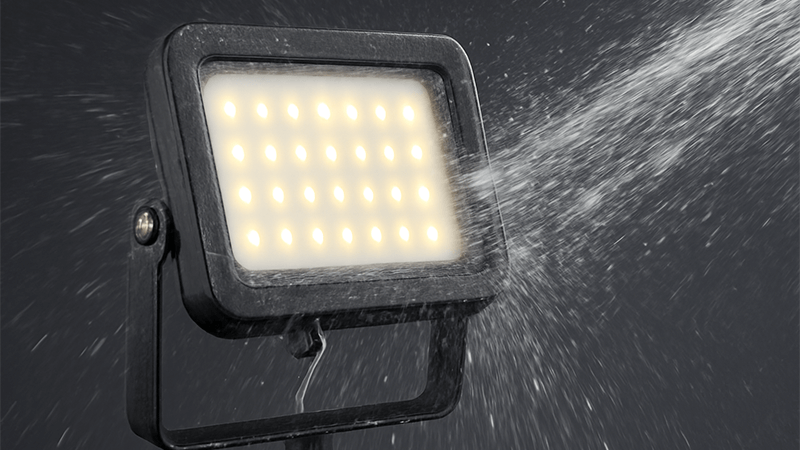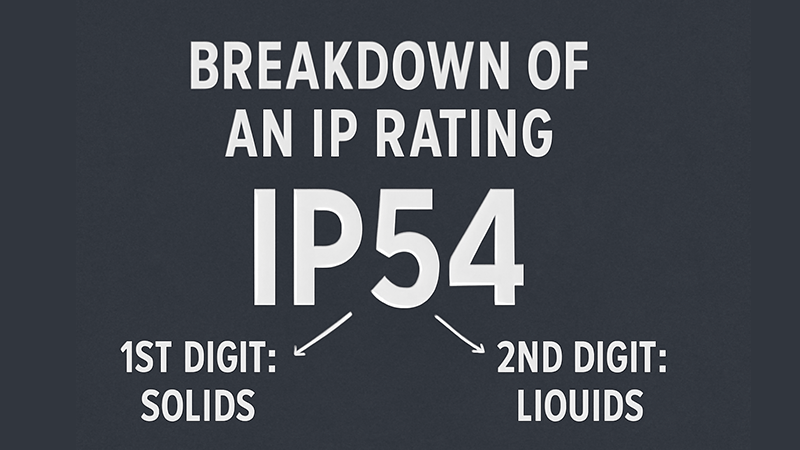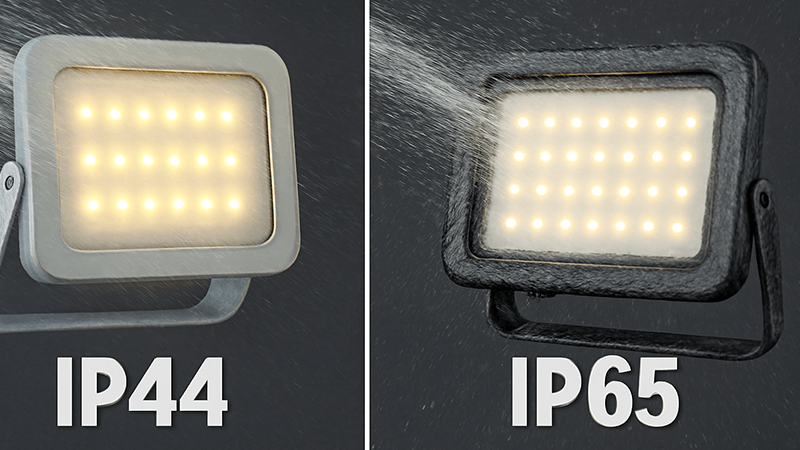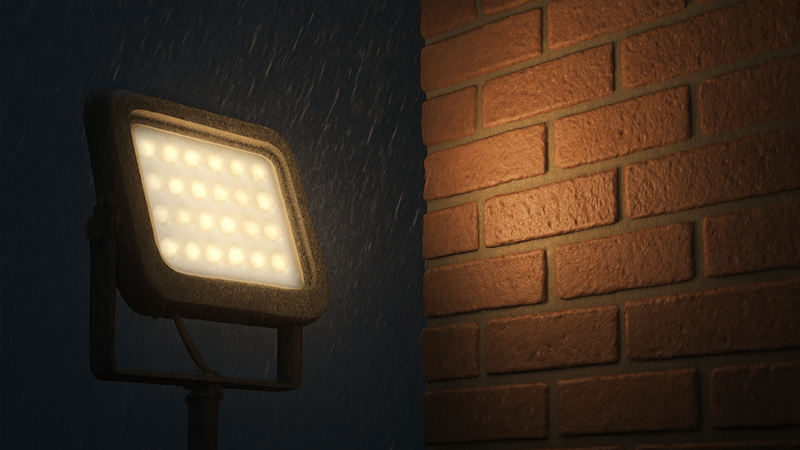Are you confused by IP ratings? Choosing the wrong one can lead to failed projects and costly replacements. I’ll help you select the right protection every time.
An IP rating tells you how well a floodlight is protected against solids (like dust) and liquids (like water). The first digit rates solid protection (0-6), and the second rates liquid protection (0-9). Higher numbers mean better protection. This is crucial for outdoor lighting durability.

Over my years in the lighting industry, I’ve seen countless projects succeed or fail based on small details like the IP rating. A purchasing manager I work with, Shaz from the UAE, knows this well. He handles large-scale projects where durability is everything. A mistake in the specs can cost his company thousands. He needs to know he can trust the numbers on a data sheet. But what do those numbers truly mean for your project? Let’s break it down into simple, practical terms so you can choose your lighting with complete confidence.
What Exactly Is an IP Rating on an LED Floodlight?
You see "IP65" on a spec sheet, but what does it really mean for the fixture’s survival? Ignoring this detail can cause lights to fail prematurely. Let me explain it simply.
An IP (Ingress Protection) rating is a standard that defines how well an electrical enclosure is sealed against intrusion from solids and moisture. For LED floodlights, this two-digit code indicates its resistance to dust and water, which is fundamental to its outdoor performance and lifespan.

The IP rating is one of the most important specifications for any outdoor light. I can’t stress this enough. It’s a universal standard, which means an IP65 rating from one honest manufacturer should mean the same thing as an IP65 rating from another. This standard gives us a common language to talk about durability.
Let’s look at the two digits separately.
The First Digit: Protection Against Solids
The first number in an IP rating tells you how well the light is protected from solid objects. This includes everything from fingers and tools to dirt and fine dust. The scale goes from 0 to 6. For outdoor floodlights, you should almost always see a ‘6’. This means the fixture is completely dust-tight. In dusty or sandy environments, like many project sites in the UAE that Shaz deals with, anything less than a ‘6’ is a huge risk. Dust can get inside, coat the electronics, and cause them to overheat and fail.
| First Digit |
Protection against solid objects |
| 0 |
No protection |
| 1 |
>50 mm, e.g., accidental hand contact |
| 2 |
>12.5 mm, e.g., fingers |
| 3 |
>2.5 mm, e.g., tools, thick wires |
| 4 |
>1 mm, e.g., most wires, screws |
| 5 |
Dust Protected (some ingress allowed) |
| 6 |
Dust Tight (no ingress at all) |
The Second Digit: Protection Against Liquids
The second number is all about water protection. This is where the decision-making gets more critical for outdoor lights. The scale runs from 0 to 9, and the right number depends entirely on the specific location of the light. A ‘5’ is very different from a ‘7’.
| Second Digit |
Protection against liquids |
| 0 |
No protection |
| 1 |
Dripping water |
| 2 |
Dripping water when tilted up to 15° |
| 3 |
Spraying water |
| 4 |
Splashing of water |
| 5 |
Water jets from any direction |
| 6 |
Powerful water jets |
| 7 |
Immersion, up to 1m depth for 30 minutes |
| 8 |
Continuous immersion, deeper than 1m |
| 9 |
High-pressure, high-temperature water jets |
Understanding this chart is key to avoiding costly failures from water damage.
Is IP44 or IP65 Better for Your Outdoor Lights?
Thinking of using an IP44 light outside to save a little money? This decision could easily backfire with water damage after the first heavy rain. Let’s compare them.
For almost all outdoor floodlight applications, IP65 is significantly better and safer than IP44. IP65 offers complete dust protection and resistance to water jets from any direction. IP44 only protects against splashing water, making it unsuitable for most exposed outdoor environments.

When I started my company, Upward Lighting, I promised to deliver quality you can see. A big part of that is helping clients choose the right product, not just the cheapest one. The IP44 versus IP65 debate is a perfect example. A purchasing manager might see two similar-looking lights, one IP44 and one IP65, with the IP44 being less expensive. It’s tempting to save on cost, but this is a classic case of a bad investment.
Let’s do a direct comparison to see why.
| Feature |
IP44 |
IP65 |
| Solid Protection |
4: Protects against objects >1mm (wires) |
6: Completely dust-tight. No dust can enter. |
| Liquid Protection |
4: Protects against splashing water. |
5: Protects against water jets from any angle. |
| Best Use Case |
Sheltered areas like porch ceilings, some bathrooms. |
Building facades, garden lighting, parking lots. |
| Real-World Test |
Survives light rain if sheltered. Fails in a storm or if sprayed with a hose. |
Survives heavy storms and being cleaned with a pressure washer. |
The difference is huge. An IP44 light might be acceptable for a fixture tucked up under a deep, protected eave where it will only ever see a light mist. But a floodlight is, by definition, meant to light up an open area. It will be exposed to driving rain, wind, and even cleaning crews with pressure washers. An IP44 fixture will fail under these conditions. The seal is not strong enough to stop water jets, and the solid protection rating of ‘4’ leaves it vulnerable to fine dust. For any serious outdoor project, especially for my clients like Shaz who manage large commercial installations, IP65 is the absolute minimum I recommend. The small initial saving on an IP44 light is quickly lost to replacement costs and labor.
What IP Rating Does Your Specific LED Light Need?
It’s easy to think all LED lights need the same protection. But an indoor office light has very different needs than a floodlight on a coastal building. Choosing incorrectly leads to overspending or premature failure.
There is no single IP rating for all LED lights. The required rating depends entirely on the application’s environment. Indoor lights may only need IP20, while outdoor floodlights typically require IP65 or higher. Underwater lights need IP68. Always match the rating to the location.

As a manufacturer, our goal at Upward Lighting is to provide customized solutions. We can’t do that with a "one-size-fits-all" approach. The right IP rating is a core part of that customization. You wouldn’t use a delicate indoor chandelier in a garden, and you don’t need an expensive IP68 submarine light for an office ceiling. It’s about finding the perfect balance of protection and cost for the specific job. I always guide my clients to think about the environment first.
Here’s a simple guide to help you match the IP rating to the application.
| Application |
Common IP Rating |
Why It’s Chosen |
| Indoor Office/Retail |
IP20 |
Protected from fingers, but no water protection is needed in a dry, clean space. |
| Bathroom (Zone 2) |
IP44 |
Protected from splashes of water. Not for use inside the shower. |
| Building Facade |
IP65 |
Dust-tight and protected from rain and cleaning with water jets. |
| Garden/Walkway (Ground) |
IP67 |
Dust-tight and protected from temporary immersion if water pools after rain. |
| Pools/Fountains |
IP68 |
Dust-tight and designed for continuous submersion in water. |
I once worked on a hotel project where the designer specified the same lights for the lobby and the outdoor pool deck. The lobby lights were IP20, and they looked great. The problem was, they ordered IP20 for the pool deck as well. It was a costly mistake. Within a few months, the coastal air and humidity caused them to corrode and fail. We replaced them with proper IP66 marine-grade fixtures. This experience taught me to always, always start the conversation with "Where exactly will this light be installed?". It’s the most important question to ask to determine the right IP rating.
What Is a Good IP Rating for Outdoor Lights?
You have an outdoor project. Picking a "good enough" IP rating can feel like a gamble that could cost you later. I will show you how to choose the right rating with confidence.
A good baseline IP rating for general outdoor lights is IP65. It ensures the fixture is completely dust-tight and can withstand heavy rain and water jets. For areas with a risk of temporary flooding, you must upgrade to at least IP67.

This is the question I get most often. My straightforward answer is this: start with IP65 and go up from there if needed. Based on my insights from years of manufacturing, here is how you should decide.
Choosing Between IP65, IP66, IP67, and IP68
Your choice depends on how much water the light will face.
-
IP65/IP66 for Exposed Areas: If the light will be installed on a wall, a pole, or under an eave—where it gets rained on or might be washed down—IP65 is your reliable standard. It’s designed to resist jets of water. IP66 offers protection against even more powerful jets. For most building facades, architectural lighting, and landscape lights, IP65 is perfectly sufficient and provides a great balance of performance and cost.
-
IP67/IP68 for High-Risk Areas: This is critical. If you are installing a light in the ground, in a low-lying spot, or near a body of water like a dock, you must consider the risk of submersion. Even a short time underwater can destroy an IP65 light.
- Choose IP67 if the light might be temporarily submerged in pooled water after heavy rain (up to 1 meter for 30 minutes). This is common for in-ground uplights in plazas or gardens.
- Choose IP68 if the light will be permanently underwater, like in a fountain or pond.
Beyond the Rating: Structural Design Matters
A high IP rating on the box means nothing if the product is poorly designed or built. I’ve personally inspected failed "IP67" lights that were letting water in through cheap, brittle gaskets or poorly fitted seals. Verification is key.
At my factory, we know that achieving a true IP rating is about more than just gaskets. It’s about intelligent engineering. For some of our high-performance sealed fixtures, we integrate a breather valve. This is a small, specialized membrane that lets air pressure equalize between the inside and outside of the fixture as it heats up and cools down. Without it, the pressure changes can create a vacuum effect that sucks in moisture, even on a well-sealed light, leading to internal condensation and failure. This small detail is a mark of a truly high-quality outdoor light.
Always ask your supplier for their IP test reports. A reputable manufacturer will have this documentation ready. It’s your proof that the light performs as promised.
Conclusion
Choosing the correct IP rating is not that complex. For most outdoor lights exposed to rain, use IP65. For any risk of submersion, upgrade to IP67 or higher.